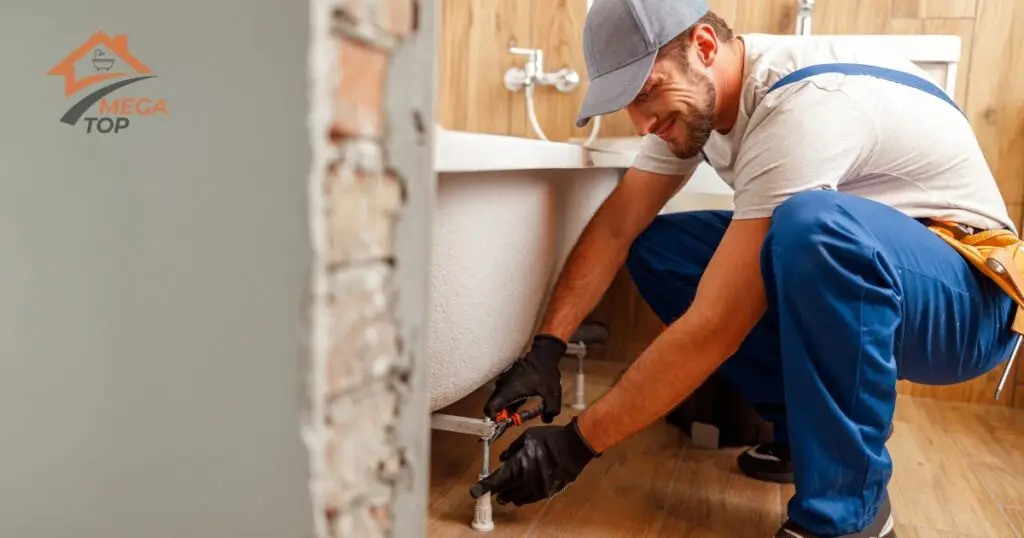Overview of Bathtub Installation: Understanding Support Needs
Properly supporting a bathtub during installation is crucial for ensuring stability, preventing movement, and avoiding long-term issues like cracking or water damage. Depending on the bathtub type and bathroom layout, different support methods are used to keep the tub secure.
Why Proper Support is Crucial for Bathtub Installation
Without adequate support, a bathtub can shift, causing leaks, structural damage, or even breakage over time. Proper support helps:
- Prevent Cracking: Especially important for materials like acrylic or fiberglass, which may crack if not properly supported.
- Avoid Movement: Securing the tub in place reduces the risk of shifting, which could damage plumbing connections.
- Reduce Water Damage: Stability ensures that water stays contained, preventing leaks and potential water damage.
Common Bathtub Materials and Their Support Needs
Each type of bathtub material requires specific support considerations:
- Acrylic Tubs: Lightweight but flexible, acrylic tubs benefit from mortar beds or foam support for added stability.
- Cast Iron Tubs: Heavier and highly durable, cast iron tubs generally rely on their weight but still need level floors and secure footing.
- Fiberglass Tubs: Light and affordable, fiberglass tubs require a solid base, often with mortar, to prevent flexing and cracking.
- Steel Tubs: Heavier than acrylic but not as weighty as cast iron, steel tubs typically need framing and sometimes mortar support.
Types of Bathtub Supports
Framing for Built-In Bathtubs
For built-in tubs, like alcove and drop-in styles, wooden framing provides a sturdy foundation.
Creating a Wooden Frame for Stability
A wooden frame built to fit the tub’s dimensions offers critical support. The frame:
- Provides a stable perimeter that holds the tub in place.
- Distributes the tub’s weight to prevent sagging or shifting.
Securing Frame to Wall Studs
The frame is usually secured to the floor and wall studs with screws or bolts. This connection ensures that the tub remains securely anchored, preventing lateral movement during use.
Mortar Beds for Bathtub Installation
A mortar bed, or mortar base, is a layer of cement or mortar applied under the tub. It acts as a solid, molded base, providing stability and even weight distribution.
Benefits of Mortar Support for Tub Stability
- Increased Stability: Mortar forms a custom-fit support layer that evenly distributes weight.
- Reduced Flexing: Especially useful for acrylic and fiberglass tubs, mortar minimizes flexing, helping prevent cracks.
How to Install a Mortar Bed
- Mix the mortar to a thick, workable consistency.
- Spread the mortar evenly across the installation area where the tub will sit.
- Carefully lower the tub onto the mortar, pressing gently to create an even, solid base.
Adjustable Legs and Feet for Freestanding Tubs
Freestanding tubs often come with adjustable legs or feet that help level and stabilize the tub, especially on uneven floors.
How Adjustable Legs Provide Support
Adjustable legs allow you to raise or lower each corner of the tub, ensuring a level surface.
Leveling and Securing Legs
- Place the tub in the desired position and adjust each leg as needed to level.
- Tighten the legs securely to prevent shifting during use.
Step-by-Step Guide to Securing a Bathtub
Step 1: Preparing the Installation Area
Prepare the installation area by:
- Checking the Floor: Ensure it’s level and structurally sound.
- Locating the Plumbing Connections: Verify that the drain and water supply lines are correctly aligned.
Step 2: Building a Frame for Alcove or Drop-In Tubs
For built-in tubs, start with a sturdy frame.
Measuring and Cutting Frame Pieces
Measure the dimensions of the tub and cut the wood frame pieces accordingly.
Securing the Frame to Floor and Wall Studs
Attach the frame to wall studs and the floor using screws or bolts, ensuring the frame is stable and square.
Step 3: Applying a Mortar Bed for Added Support
A mortar bed provides a solid base that keeps the tub from shifting.
Tips for Mixing and Spreading Mortar
- Mix the Mortar: Follow the manufacturer’s instructions to achieve a thick consistency.
- Apply the Mortar Bed: Spread the mortar bed evenly within the framed area, focusing on areas that need extra support.
- Position the Tub: Gently set the tub into the mortar, pressing to ensure contact for even support.
Step 4: Installing Freestanding Bathtubs with Adjustable Legs
For freestanding tubs, position the tub on its legs and adjust each leg to achieve a level placement.
Reinforcing and Testing Bathtub Stability
Once the tub is installed, checking its stability is essential to prevent future issues.
Ensuring Proper Alignment and Leveling
Verify that the tub is perfectly level using a carpenter’s level. This helps prevent uneven weight distribution, which could lead to cracking or loosening over time.
Testing for Movement and Reinforcing as Needed
Apply slight pressure around the edges to confirm there’s no movement. If necessary, re-secure the frame, tighten leg bolts, or add more caulk.
Sealing Around the Bathtub for Waterproofing
To ensure water doesn’t seep into the walls or floor:
- Apply Silicone Caulk: Seal around the edges of the tub where it meets the walls and floor.
- Smooth the Caulk: Use a caulk smoothing tool or damp finger for a clean finish.
Common Mistakes to Avoid in Bathtub Installation
Proper bathtub support is essential for a safe, lasting installation. Avoid these common mistakes:
Insufficient Support or Framing
Skipping framing or underestimating support needs can lead to a loose tub. Always ensure a solid frame or base for the bathtub type being installed.
Skipping Mortar for Heavier Tubs
Acrylic and fiberglass tubs benefit from mortar beds, which prevent shifting. Not using mortar can lead to a flexible tub bottom, increasing the risk of cracking.
Incorrect Leveling Techniques
Improper leveling can cause water to pool and strain the bathtub structure. Always check the tub’s alignment and make adjustments to ensure a stable, level surface.
Ensuring proper support during bathtub installation is essential for a secure and stable bathtub. By choosing the right support method for your tub’s material and style, you can prevent future issues and enjoy a durable and comfortable bathtub setup.
FAQ
Not all, but heavier tubs like acrylic and cast iron benefit from a mortar base for additional stability.
Adjustable legs help level and stabilize the tub on uneven floors, preventing movement.
Freestanding tubs often don’t need frames, but alcove and drop-in tubs require framing for stability.
Mortar provides a more durable base, while foam can be used for lighter tubs. Mortar is typically preferred for longevity.
An unlevel tub can lead to water pooling, movement, and potential leaks. Proper leveling is essential during installation.





